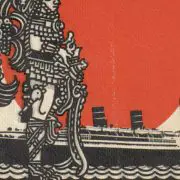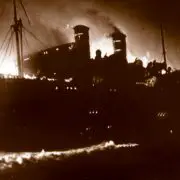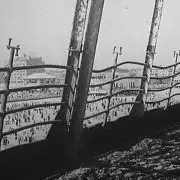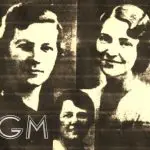Morro Castle, Mohawk and the End of the Ward Line : Part One
4. The Floating Whorehouses
The Morro Castle and Oriente settled into their working lives with ease. They were, by far, the fastest and most elegant liners regularly scheduled on the Havana run. Peak season passenger lists from the two most grim years of the depression- 1932 and 1933- show that their totals were good: low price, grand interiors, and an appealing itinerary proved to be a winning combination even during the lean years.

However, there was a dark undercurrent beneath the glamorous and placid surface presented by Ward Line publicists: rumors abounded regarding drug and alcohol smuggling; illegal alien importation; gun running and gambling. The “Havana Ferryboats” were referred to, not affectionately, by longshoremen and NYC waterfront police as “The Floating Whorehouses” because of the alleged presence of not-on-the-passenger-list call girls who worked the liners during peak convention and charter season. Particularly during her final year, enough of the Morro Castle’s misadventures appeared in the press to make the other rumors seem plausible. Presented here, in their original form, are reports about some of the more interesting events to have plagued the Ward Line publicists during the line’s turbulent final twenty five years.
We begin with an event strikingly similar to the problems that plagued the Morro Castle in 1933. In this case, the Morro Castle being discussed is the Ward Line’s original vessel of 1900.
U.S. SHIP IS HELDMexican Gunboat Has Guns Trained on Her Bow.Mrs. John Lind is AboardMorro Castle of the Ward Line, is Detained in Vera Cruz Harbor.The steamship Morro Castle of the Ward Line is holed up in Vera Cruz harbor with the guns of a Mexican gunboat trained on her bow. On board are Mrs. John Lind, wife of President Wilson’s envoy to Mexico, many other American passengers, and mail for the United States. Captain Huff, the vessels’ commander has been cited to appear tomorrow before a local judge to answer a criminal charge. What the charge is has not been told, and the Mexican authorities have not disclosed its nature. Mr. Lind, who saw his wife go on board the Morro Castle, has sent a vigorous cablegram of protest to Secretary of State Bryan, and to Minister of Foreign Affairs Mojano in Mexico City. The Morro Castle has been preparing to steam for two days. It was announced last night that Mrs. Lind would be among the passengers. All passengers were aboard this morning and the vessel was in shape to clear when word was sent out to the vessel that clearance papers had been returned by officers of the port. The pilot was warned not to go aboard. Captain Huff, with local representatives of the line, immediately took steps to learn the cause of the holding up of the vessel, and then Captain Huff was served with the citation. While these things were taking place ashore, the Mexican gunboat Zaragosa steamed from her anchorage in the shadow of the Island Fortress and took its position just off the bow of the Morro Castle. (October 23, 1913) US AND MEXICO SITUATION OMINOUSPresident Expected To Issue Ultimatum Warning Foreign Warship to Keep Away.Developments at a few hours today in the relations between the United Stares and Mexico emphasized a gravity of affairs more ominous than at any time since President Wilson’s administration began. Absolute silence was the order in official quarters. The release of the Ward Liner Morro Castle after peremptory demands by the United States terminated a delicate situation. Orders were in preparation to the commanders of American warships lying of Vera Cruz to (illegible) upon her release. (October 24, 1913) |
The reason for the impounding of the Morro Castle and the arrest warrant issued for her captain was than on her previous voyage an ‘enemy of the state’ had escaped from Mexico to Cuba aboard her, with the – rumored – knowledge of the captain and the Ward Line.
PLAN SEIZURE OF $1,500,000.00 LINEROrizaba of Ward Line May Be Held By Government For Smuggling.Seizure of the Ward line steamship Orizaba, worth more than $1,500,000.00, by the government as a rumrunner was recommended by customs officials today. The recommendation followed seizure after a running gun battle in the East River of a laden speedboat engaged in transporting liquor from the Orizaba to some point along the shore. Numerous reports of liquor coming into this city from Havana have been received by the authorities and when the Orizaba arrived yesterday from Cuba customs men were cautioned to watch the ship. The special service squad of customs inspectors, observing a launch alongside the liner gave chase and fired were more than 46 shots. They declared that they were fired on in return. Two men leaped into the water as the launch approached the dock, and the others leaped to the dock. All made their escape. 100 demi-johns of rum were seized on the craft. Assistant Solicitor of Customs Barnes recommended to Federal Attorney Buckner that the Orizaba be seized. If proceedings are instituted against the ship it will be the first time the government has sought to libel so large a steamship for a prohibition law violation. William Imlay, general manager of the Ward Line, and Samuel McElroy, chief of police of the Ward Line denied official knowledge of the smuggling. (November 13, 1925) |
As often happened during prohibition, when the headlines died down after a few days, the whole matter was dropped. The Orizaba remained in Ward Line service, and the Ward Line continued to deny that the persistent smuggling stories had any basis in fact.
REGIME SET UP IN REVOLT IS APPROVED...Machado supporter was found shot to death near the ousted president’s estate. Manuel Morales, a Machado vigilante committed suicide. Passengers aboard the Ward Liner Morro Castle, which arrived today, said that apparently the Cuban people want the world to know that General Machado is no longer their ruler. The ship was met at the docks by crowds of Cubans who shouted “Down with Machado!” and “Machado is gone!” The passengers said that similar cries went up from a gunboat which the liner passed entering the harbor. (August 15, 1933) |
The Morro Castle became a regular one-line feature in articles about the turmoil in Cuba. Protesters crying out “Cuba Si! Machado no!” met the liner several times in New York and Havana after it was ‘rumored’ that members of the Machado regime and their wealthy supporters were leaving Cuba legally, and illegally, aboard the liner.
| RETURNING EXILES MANY INFLUENCE CUBAN REGIME
Cuba awaited today the return from exile of former president Mario G. Menocal and Colonel Carlos Mendeta, and wondered what part they would play in reconstruction plans of the new provisional government. Meanwhile, as exiles returned or prepared to come back to a fatherland that has seen may changes in the past few days, others, of an opposite faith prepared to leave. Remiro Guerra, Machado’s secretary, and two others departed for New York on the steamer Morro Castle… (August 17, 1933) |
It was rumored in Havana and New York that Jose Gans, head of Machado’s feared secret police, had stowed away, or been smuggled aboard after paying off a Morro Castle crew member. Family members awaiting her arrival in NYC rubbed shoulders with protesters and members of the bomb squad, present because of the threat of retaliation against the liner.
LINER DOCKS WITH CUBAN REFUGEES.Under a heavy guard of federal agents and city police, the Ward Liner Morro Castle, with 18 Cuban refugees aboard, docked at the foot of Wall Street where a crowd of more than 500 gathered. The Morro Castle, in from Havana where some of its passengers ran the gauntlet of death in escaping the island republic, was systematically searched from stem to stern in fear that Jose Gans, former Chief of the despised Porra, secret police, was a stowaway. That N.Y. Members of the A.B.C. Revolutionary Party would have attempted the life of Gans, authorities did not doubt- just as they were certain that some members of the crowd were there for that same purpose. Federal agents, and police moved constantly through the crowd and refused admission to the pier to anyone who could not prove peaceful intentions of business. Among the refugees was Oscar P. Claras, Cuban ambassador- now without portfolio- to Washington who resolutely declined protection offered by Lt. William Fay and 16 members of the bomb and strong arm squads, who hastened aboard the Morro Castle as soon as the gangplank hit the pier. (August 21, 1933) PLOTTED TO ASSASINATECuban Admits Plan Against Machado’s “Butcher.”A young Cuban rebel, chosen by lottery to come to America and assassinate Ludao, known as “Machado’s Butcher” was prevented from landing here by immigration officers when he arrived, a stowaway aboard the Morro Castle. The handsome member of the A.B.C., Cuban secret society, was Alfonso Cassas, 20, a student whose resemblance to the late Rudolph Valentino had brought about his rescue from the ship’s brig by romantic young women passengers who pleaded with the ship’s captain for his release. Freed from the brig, Cassas appeared on deck in borrowed flannels and showed his gratitude to his fair rescuers by dancing the rumba with them and forgetting revolutions and secret missions for the moment. He told his story. “It was all settled one night outside Havana. There was a meeting. We drew lots from a paper bag. It fell to me, this magnificent thing to do- kill Ludao. It was the happiest moment of my life. I got on the Morro Castle– never mind how. I had reason to believe that Ludao was a passenger under an assumed name. Asked if he would have killed Ludao, Cassas drew himself up and with a gleam in his black eyes said simply “I would have wrung his neck.” (September 9, 1933) |
The following story is a prelude to one of the worst voyages of the Morro Castle’s brief life.
CUBANS ANGRY AT ISLAND MANAGER OF UNITED FRUIT CO.Soldiers Guard Mr. Molamphy on Ship as He Sails for America.Ambassador Welles prevented an incident that at the moment might have caused intervention when a group of students, port workers, and members of the A.B.C. radical society sought to prevent the sailing on the steamship Morro Castle of Mathew T. Molamphy, American general manager of the United Fruit Company, whom they accused of instigating the assassination of Margarita Iglesias, a worker whose body was found under the stables of Morales Fortress. Welles warned them of the seriousness of seeking to detain an American and obtained their word of honor that they would not permit interference with his departure. The government rushed a company of soldiers to the Ward Line docks, while Lieutenant-Colonel Thomas Gimperling, American Military Attache, went aboard the Morro Castle to see to Molamphy’s safety. Angry dockworkers sought to board the ship in search of Molamphy, but the soldiers kept them back. The ship sailed with him aboard. (September 13, 1933) LINER BATTERED BY SEVERE STORMTossed and battered by the worst storm in the history of its veteran master, the Ward Liner Morro Castle docked in New York today,two days behind schedule. Of the 149 passengers and 200 crew, more than 70 had suffered cuts and bruises during the raging storm that swept away the liner’s radio mast. Captain Robert R. Wilmott, who stayed on the bridge for 75 hours without relief said he had never experienced anything its equal during many years of at sea. Although many of the passengers were frightened, Captain Wilmott was high in his praise of most of them- particularly Miss Gwendolyn Taylor, pretty young business secretary from Philadelphia, who went into the lounge where many of the passengers had gathered and very calmly began to play the piano. The Morro Castle put out from Havana on Wednesday night. Friday afternoon a gigantic wave struck the liner broadside. The radio was disabled, and the Morro Castle took a sickening list to port. “We thought she was gone then, for sure” one member of the crew said today. (September 18, 1933) .the 140 passengers huddled in the lounge because their cabins were ankle deep in water. (September 19, 1933) YOUNG WOMAN SINGS JAZZ AS STORM RAGESPassenger Aboard Buffeted Liner Does Best To Keep Up Spirits of Those On Board as Disaster Threatens.Caught in a howling storm at sea with no means of communicating with the rest of the world, passengers aboard the steamship Morro Castle passed a fearful night singing and praying, trying not to think of disaster. The passengers debarking here on Monday told how Gwendolyn Taylor, 22, a blonde business girl of Philadelphia, thumped away at a piano all Friday night to keep up spirits when the ship was beating sharply against the crashing waves. The ship’s orchestra was too sick to play. “I thought I ought to do something” said Miss Taylor, “as I was one of the few women who weren’t sick. The only thing I could do was play, so I played and sang. Only cheerful things. I think some of the people wanted to hear hymns, but I thought they needed jazz more. Some of them joined in the singing and others continued to pray. (September 20, 1933) SMUGGLING OF GOLD TO MEXICO SUSPECTEDWidespread smuggling of gold into Mexico from neighboring countries, including the United States, was suspected by authorities today. Five tons of gold bars and coins worth nearly $4,000,000.00 have been shipped from Vera Cruz and shipments worth as much were made in recent preceding weeks, it was learned. Authorities have intimated that they believed large sums were being brought into Mexico by airplane in order that their owners might evade embargoes and take advantage of the lack of duty on gold in Mexico. Cuba was believed to be the principal source of coins which have come into the country in great quantities. Coins are bought in Havana at a 12% premium, smuggled into Mexico and sold at 100% profit. Three tons of gold bar and coins were shipped from Vera Cruz Thursday night aboard the Orizaba. The Morro Castle left the same port earlier in the week with two tons of coins and bars. Reports of earlier shipments were frequent. (October 25, 1933) MORRO CASTLE RUNS BLOCKADE IN CUBAWith bullet marks on her bulkheads, the liner Morro Castle docked today after running through the gunfire of rebel troops in Havana harbor. A machine gun bullet from the ABC rebel troops, barricaded in the Atarea Fort tore off a portion of the ship’s bridge, while other bullets whistled through the aft rigging. The liner steamed from Havana harbor just as the fort opened fire on two Cuban gunboats in the harbor. The liner, an American ship, was in between, put on full steam and hurriedly cleared the harbor. Captain Jones, master of the ship, ordered all decks cleared, but some passengers came on deck to snap pictures of the battle. Jones said the gunboats maneuvered to use the liner as a shield to get in a more advantageous position to fire upon the fort. In the words of one passenger, Gertrude Conlon of Newark, New Jersey, “It was simply terrible. I loved every moment of it.” The liner brought to safety two Cuban Army officers, part of those who rebelled against the Grau government and commandeered the National Hotel a few weeks ago. Both of them escaped from Cubana Prison, where the officers were quartered after surrendering. They jumped aboard the ship just as the gangway was being lowered and their baggage was hauled aboard by lines. (November 12,1933) |
Ambassador Sumner Welles had boarded the Morro Castle earlier that day and advised that Captain Jones depart prematurely. The liner sailed 45 minutes ahead of schedule, making the timing of the arrival of the escapees seem a bit odd. Other accounts mentioned that the passengers were herded into the lounge and the orchestra played “Happy Days Are Here Again” to drown out the gunfire and shouting from outside as the liner picked up speed and drew away from the gunboats Cuba and Patria. The two boats had been “hovering” in Havana harbor according to witnesses, and as the Morro Castle cleared her dock, “darted” to the leeside of the liner before opening fire on Atarea Fortress. None of the forty-odd passengers aboard the ship at the time were injured, although the liner arrived in New York looking “scarred” and missing a section of her aft docking bridge that had been torn away by machine gun fire.
During this turbulent period, the Oriente continued her Wednesday to Wednesday New York/Havana/New York round trips without incident. She seldom made the newspapers, except in the context of “Mrs John Stevenson and her daughter Elizabeth of Park Hill Road will be sailing for Havana this Wednesday aboard the Oriente” notices on the society pages of small towns and mid-sized cities, and the disparity between her service career and that of the Morro Castle is compelling. One wonders: were the captain and crew of the Oriente more honorable than their cohorts on the Morro Castle or simply better at concealing what they were doing?







